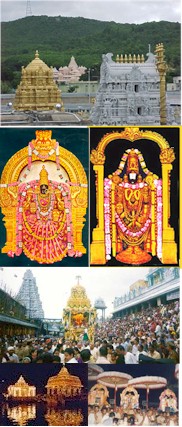Welcome to Adiyen Sri Ramanuja Dasan !
" Srimathe Ramanujaya Namaha !"
20. Q .: will the arjitham ticket holders for koil azhwar tirumanjanam be allowed to apply the paste in the surroundings of the temple (excluding the place from bangaru vakil and sanctum).
Ans .: No, the ticket Holders are allowed for Darsan immediately after the Koil Alwar THirumanjanam is performed and the II Bell is offered. They are not allowed to apply paste.
21. Q .: the piligrims influx is high during the new year.is new year observed as a result of heavy influx,because ugadi is the new year according to hindhu calender and is also observed grandly in tirumala through ugadi asthanam.
Ans .: There are no special Sevas, rituals on the day of January 1st. Except the Dhanurmasa Puja, evrything is like a normal day. But as people have used to English calendar, most of them will celebrate it as if it were a part of our culture. But as far as the Temple and Lord Balaji is concerned, Ugadi is Newyear here and So Vishesha Aradhana is celebrated at that time. So to make devotees(who have used to celebrate newyear on Jan 1st) happier on this day, the special Flower Decorations inside the Temple is done.
22. Q .: We all know that the worship in Tirumala temple is according to Vaikhanasa Agama Shastram. According to Vaikhanasa Agama, there will be one Main Deity(mulavirat) and a deity which can be moved (Bhoga murthy) and these two murthis are connected with a thread. It is said that the Bhoga murthy is presented by Pallava Queen Samavai in 614 AD. So my doubt is before this murthi is presented, how was the sevas like Ekanta seva (and other sevas which are currently being performed to Bhoga Murthi) performed in those days? Is the BHOGA SREENIVASA MURTHY always connected to the MULAVAR thru a thread,like the way it is done during sahasra kalashabhishekam? Is the BHOGA SREENIVASA MURTHY adorned with red tilakam rather than kasturi tilakam ?
Ans .: When the Hill Shrine began to attract people from the neighbouring tracts, and when festivals within the shrine had to be resorted to fro various reasons, the need fro a kautuka bera was strongly felt. The Dhruva Bera (or MulaVirat) was in itself sufficient for the devotees who aspired only for peace and salvation.But when devotees who were also mundane in their approach and aspiration flocked at the shrine, the dhruva bera had to have a kautuka bera along with it, for it is said in Kasyapa's Jnana Kanda,
Ihikamushmikapekshi dhruvakautuka samyuktham|
kevalaamushmikapekshi dhruvarchanam kuryaat|
('Ihika' means Earthly Pleasures, 'Aamushmikam' means Salvation)
This need was fulfilled in 614 A.D. by the Pallava princess Samavai, She was the first person(recordedly) to contribute to the glory of the shrine. Her endowments have been recorded on the northern wall of the first prakara. She is described here as the daughter of a Pallava chieftain (Pallava Pergadaiyar) and wife (Perindevi) of Kada-pattigal (chief of Kadava or Pallava tribe) Sakti-vitanka, who was a feudatory of the Pallava prince Mahendra-varman I (600-630 A.D.)
She got made a silver image as kautuka-bera, and arranged for Brahmotsavam. The image made of silver is a very small one and was called by her Manavalapperumal. It is generally known as Bhoga-Srinivasa. This latter name suggests that it is the recipient of all worship(bhoga), principally daily worship(karmarchana), ceremonial bath(snapana) and bed(Sayana).
She then presented several ornaments to this idol and made provisions for food offerings in the daily worship.This marked the begining of real history of the hill shrine. The first documented endowments of land were made by this lady. More than all this, the practice of employing metallic and moveable idols for formal and regular worship in accordance with Agama requirements, which Samavai brought into vogue, contributed to the ever increasing popularity of the hill shrine.
Jai Srimannaryana !
Thanks for your valuable time. Visit our web site again for more information and latest updates.

